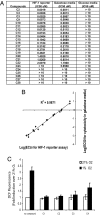A chemical genomics screen highlights the essential role of mitochondria in HIF-1 regulation
- PMID: 18172210
- PMCID: PMC2224181
- DOI: 10.1073/pnas.0706585104
A chemical genomics screen highlights the essential role of mitochondria in HIF-1 regulation
Abstract
Hypoxia-inducible factor-1 (HIF-1) plays an essential role in tumor development and progression by regulating genes that are vital for proliferation, glycolysis, angiogenesis, and metastasis. To identify strategies of targeting the HIF-1 pathway, we screened a siRNA library against the entire druggable genome and a small-molecule library consisting of 691,200 compounds using a HIF-1 reporter cell line. Although the siRNA library screen failed to reveal any druggable targets, the small-molecule library screen identified a class of alkyliminophenylacetate compounds that inhibit hypoxia-induced HIF-1 reporter activity at single-digit nanomolar concentrations. These compounds were found to inhibit hypoxia but not deferoxamine-induced HIF-1alpha protein stabilization. Further analysis indicated that the alkyliminophenylacetate compounds likely inhibit the HIF-1 pathway through blocking the hypoxia-induced mitochondrial reactive oxygen species (ROS) production. Strikingly, all of the nonalkyliminophenylacetate HIF-1 inhibitors identified from the small-molecule library screen were also found to target mitochondria like the alkyliminophenylacetate compounds. The exclusive enrichment of mitochondria inhibitors from a library of >600,000 diverse compounds by using the HIF-1 reporter assay highlights the essential role of mitochondria in HIF-1 regulation. These results also suggest that targeting mitochondrial ROS production might be a highly effective way of blocking HIF-1 activity in tumors.
Conflict of interest statement
The authors declare no conflict of interest.
Figures






Similar articles
-
Identification of novel small molecule inhibitors of hypoxia-inducible factor-1 that differentially block hypoxia-inducible factor-1 activity and hypoxia-inducible factor-1alpha induction in response to hypoxic stress and growth factors.Cancer Res. 2005 Jun 1;65(11):4918-28. doi: 10.1158/0008-5472.CAN-04-4453. Cancer Res. 2005. PMID: 15930314
-
An abnormal mitochondrial-hypoxia inducible factor-1alpha-Kv channel pathway disrupts oxygen sensing and triggers pulmonary arterial hypertension in fawn hooded rats: similarities to human pulmonary arterial hypertension.Circulation. 2006 Jun 6;113(22):2630-41. doi: 10.1161/CIRCULATIONAHA.105.609008. Epub 2006 May 30. Circulation. 2006. PMID: 16735674
-
Identification of a novel small-molecule inhibitor of the hypoxia-inducible factor 1 pathway.Cancer Res. 2005 Jan 15;65(2):605-12. Cancer Res. 2005. PMID: 15695405
-
Mitochondria and cellular oxygen sensing in the HIF pathway.Biochem J. 2008 Jan 1;409(1):19-26. doi: 10.1042/BJ20071249. Biochem J. 2008. PMID: 18062771 Review.
-
Cellular redox status regulates hypoxia inducible factor-1 activity. Role in tumour development.J Exp Clin Cancer Res. 2007 Mar;26(1):39-50. J Exp Clin Cancer Res. 2007. PMID: 17550131 Review.
Cited by
-
Toxins in botanical dietary supplements: blue cohosh components disrupt cellular respiration and mitochondrial membrane potential.J Nat Prod. 2014 Jan 24;77(1):111-7. doi: 10.1021/np400758t. Epub 2013 Dec 11. J Nat Prod. 2014. PMID: 24328138 Free PMC article.
-
Cork-in-bottle mechanism of inhibitor binding to mammalian complex I.Sci Adv. 2021 May 14;7(20):eabg4000. doi: 10.1126/sciadv.abg4000. Print 2021 May. Sci Adv. 2021. PMID: 33990335 Free PMC article.
-
Succinate dehydrogenase inversely regulates red cell distribution width and healthy life span in chronically hypoxic mice.JCI Insight. 2022 Sep 8;7(17):e158737. doi: 10.1172/jci.insight.158737. JCI Insight. 2022. PMID: 35881479 Free PMC article.
-
The Mitochondrial Respiratory Chain Is Required for Organismal Adaptation to Hypoxia.Cell Rep. 2016 Apr 19;15(3):451-459. doi: 10.1016/j.celrep.2016.03.044. Epub 2016 Apr 7. Cell Rep. 2016. PMID: 27068470 Free PMC article.
-
Targeting Mitochondrial ROS Production to Reverse the Epithelial-Mesenchymal Transition in Breast Cancer Cells.Curr Issues Mol Biol. 2022 Oct 29;44(11):5277-5293. doi: 10.3390/cimb44110359. Curr Issues Mol Biol. 2022. PMID: 36354671 Free PMC article.
References
Publication types
MeSH terms
Substances
Grants and funding
LinkOut - more resources
Full Text Sources
Other Literature Sources

